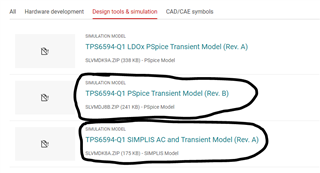Hello sir,
I check the TPS6594-Q1 datasheet and app note and can't find TPS6594-Q1 BUCK and LDO related external components value calculation formula, including inductor value, input/output capacitors, output ripple. Could you provide related documents to calculate them? I know the datasheet has recommended typical value, but I also want to calculate them by formula to check if apply for our use case. I also want to check the BUCK's loop steady and transient response, how to calculate or validate them for TPS6594-Q1 BUCK?
BTW, could you explain me the reason, in PDN_3F power solution, why TPS6594133A-Q1 switching frequency is set to 4.4MHz in default NVM, not 2.2MHz. I notice for PDN_0C power solution, TPS65941213 switching frequency is set to 2.2MHz in default NVM. Why for the same family TPS6594-Q1, different dedicated part number the switching frequency is different, what's your consideration?
BR.
Cynthia



